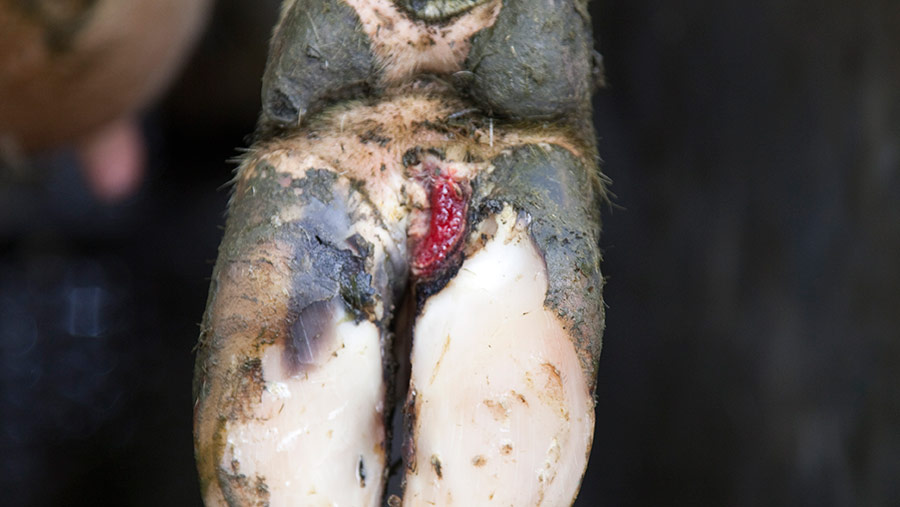‘Blitz’ treatments of topical antibiotics cut digital dermatitis
 © Anthea Kitching
© Anthea Kitching Carrying out “blitz treatments” on digital dermatitis using topical antibiotic spray has been proven to dramatically lower the number of active lesions from 49 to one during a five-month period, a farm trial has demonstrated.
Using licensed topical antibiotics treatments for three consecutive days was also found to lower antibiotics use, with just 1.5g of antibiotics used per cow for the 49 cows treated.
Vet Sara Pedersen of Farm Dynamics was commissioned to undertake a trial at Marcross Farm, in the Vale of Glamorgan, as part of Arla’s sustainable dairy strategy workshops, delivered by Kite Consulting.
See also: Tips on on beating digital dermatitis
Arla supplier Hopkin Evans, who milks 150 cows averaging more than 9,000 litres a cow a year, had been suffering with recurrent flare ups of digital dermatitis despite regular foot-bathing with formalin and spot treatment of infected cows.
The trial
In August last year, cows’ hind legs were washed off with a low-pressure hose in the parlour and their feet were then inspected. Those thought to be infected with DD were marked for inspection in the crush by Miss Pedersen the following day.
She identified 37% of the herd had DD lesions. Of the 79 lesions present:
- 46 were active
- 26 were healing
- Four were dormant
- Three were recurring
Treatment
All active and recurring lesions were treated with topical oxytetracycline spray (see “Application protocol”) in the crush to comply with Red Tractor guidelines, which prohibits cows to be treated with antibiotic spray in the parlour.
Application protocol
- Lesion washed with clean water
- Lesion dried gently using swabs
- Lesion sprayed with topical solution
- Left to dry for 30 seconds
- Lesion sprayed a second time
- Foot lowered
These animals were re-examined for two consecutive days and repeat treatments given where necessary.
These cows were not foot-bathed during the treatment period to ensure the spray did not wash off.
After the three days only eight of the initial 49 lesions were not healing successfully and these animals were treated for another three consecutive days.
Foot-bathing protocols
Foot-bathing routine and hygiene was also stepped up to prevent further flare ups of dd.
Previously, Mr Evans was foot-bathing cows four times a week using 5% formalin. However, on Miss Pedersen’s advice he stepped this up to daily and will soon be foot-bathing the dry cows twice weekly too.
Alterations were made to the foot-bath to take it from 2m long to 4m long and 60cm wide. This has helped the number of hind foot immersions double from to at two if not three.
An overflow pipe was also installed at 10cm so the foot-bath cannot be overfilled and formalin diluted.
Results
At the six week review the percentage of hind feet with active or recurring lesions had dropped to 1% and at five months it stood at just 0.3%.
Number of active or recurring lesions |
|||
|
Number of active or recurring lesions |
Number of cows with active or recurring lesions |
% of hind feet with active or recurring lesions |
|
|
Start of study |
49 |
37 |
17 |
|
Six-week review: day 44 |
3 |
3 |
1 |
|
Five-month review: day 142 |
1 |
1 |
0.3 |
Which is the best treatment to use?
Revealing the results at British Cattle Lameness conference at Sixways Stadium last week (26 April), Miss Pedersen urged farmers to stop using unlicensed antibiotic foot-baths.
She said each farm should discuss lameness protocol with their vet and explained how topical antibiotics sprays were a better solution than systemic treatment and bandaging.
“Currently the only licensed systemic antimicrobial in the UK is cefquinome and as it’s a fourth-generation cephalosporin [critically important antibiotic] it must be considered whether its use is responsible.
“Bandaging is commonly used, but it’s costly and can create the perfect environment for DD to thrive once the product is no longer active. They are commonly used to hold products on to the lesion that we shouldn’t be using such as unlicensed antibiotic powders or caustic copper sulphate pastes.
“Antibiotics sprays are licensed, so there is no risk of milk contamination, it works if done correctly and it isn’t painful to the cow.”
